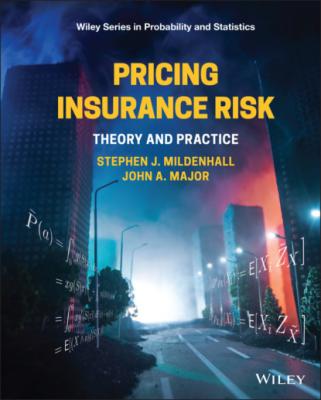Pricing Insurance Risk. Stephen J. Mildenhall
Чтение книги онлайн.
Читать онлайн книгу Pricing Insurance Risk - Stephen J. Mildenhall страница 29

Exercise 30 Apply the Algorithm to X + 100.
Solution. Step (1) now introduces the 0 row, see Table 3.3.
Table 3.3 Solution to Exercise 30.
| j | X | ΔX | PX=ΔS | S | X ΔS | S ΔX |
|---|---|---|---|---|---|---|
| 0 | 0 | 100 | 0 | 1 | 0 | 100 |
| 1 | 100 | 1 | 0.250 | 0.75 | 25 | 0.75 |
| 2 | 101 | 7 | 0.125 | 0.625 | 12.625 | 4.375 |
| 3 | 108 | 1 | 0.125 | 0.5 | 13.5 | 0.5 |
| 4 | 109 | 1 | 0.0625 | 0.4375 | 6.8125 | 0.4375 |
| 5 | 110 | 1 | 0.125 | 0.3125 | 13.75 | 0.3125 |
| 6 | 111 | 79 | 0.0625 | 0.25 | 6.9375 | 19.75 |
| 7 | 190 | 8 | 0.125 | 0.125 | 23.75 | 1 |
| 8 | 198 | 2 | 0.0625 | 0.0625 | 12.375 | 0.125 |
| 9 | 200 | 0.0625 | 0 | 12.5 | ||
| Sum | 127.25 | 127.25 |
Exercise 31 The loss outcomes are all distinct in Table 3.2. When there are ties, Step (3) is needed. Recompute the table if X1 can take values 1,9,10.
The algorithm’s computations can be visualized using a Lee diagram, as shown in Figure 3.13. The horizontal axis shows events and their cumulative probabilities (in 1/16ths and decimals). The width of each event corresponds to its objective probability, ΔS in the table. The vertical axis shows potential outcomes from 1 to 100. The horizontal black lines show the outcome X for each event. In this case, there are nine events with nine distinct outcomes. The shaded area shows the chances each unit of assets is needed to fund an event. For example, the 99th and 100th units are only at risk from (or needed to fund) event j = 9, which